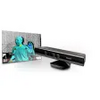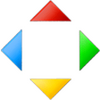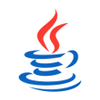Developer tool for Kinect technology
Developer tool for Kinect technology
Vote: (2 votes)
Program license: Free
Developer: Microsoft
Version: 2.0
Works under: Windows
Vote:
Program license
(2 votes)
Free
Developer
Version
Microsoft
2.0
Works under:
Windows
Comprehensive Development Framework for Kinect
The Kinect for Windows SDK is an advanced programming toolkit designed for developers to create applications leveraging Microsoft's innovative motion-tracking and depth-sensing technology. As an essential resource for developers, this SDK integrates seamlessly with Visual Studio, and it can be employed in an array of applications spanning from interactive advertising to intricate user interface navigation.
Deep Integration with Advanced Sensors
The Kinect for Windows SDK offers access to the sophisticated raw data streams from the Kinect sensor. These streams include color, depth, and infrared—providing a robust foundation for developers to extract environment information, which is crucial for augmented reality experiences or any application that requires environmental understanding. The underlying technology offers a promising avenue for enhancing user-computer interaction beyond the conventional means.
Enhanced User Interaction through Skeletal Tracking
Skeletal tracking is one of the cornerstone features of this SDK, enabling the development of applications for up to two people simultaneously. This functionality broadens the horizon for collaborative interactions and multiplayer experiences in the same physical space, redefining the human-machine interface. Developers working on applications for education, healthcare, or fitness, where movement and posture are significant, will find this feature particularly invaluable.
Support for Multi-Disciplinary Development Languages
Offering support for popular programming languages such as C++, C#, and Visual Basic, the Kinect for Windows SDK is remarkably accessible to a wide range of developer expertise. Whether the developers come from an object-oriented programming background or are comfortable with Microsoft's .NET framework, this SDK is equipped to facilitate development across various disciplines and project requirements.
Resources for Developers
To jumpstart development, the SDK includes numerous sample codes, or 'walkthroughs,' allowing developers to familiarize themselves with how to integrate Kinect's capabilities into their applications effectively. These are pivotal for learning best practices and gaining insights into potential usage patterns, hence significantly reducing the learning curve and accelerating the development process.
The Kinect for Windows SDK is an exploration ground for developers eager to delve into Microsoft's motion tracking technology. The SDK's release heralds a new era of interactive possibilities for Windows-based systems, much like the success Kinect has enjoyed in the gaming world via Xbox consoles.
Potential for a Myriad of Applications
The Kinect technology has far-reaching potential, not only in gaming but also in various domains including retail, education, and rehabilitation. The ability to track and interpret human movements can give rise to innovative, hands-free applications that can transform the way users interact with computers, offering a more natural and intuitive experience.
Pros
- In-depth access to raw sensor data streams
- Support for skeletal tracking of two people simultaneously
- Compatibility with multiple programming languages
- Comprehensive sample code and resources for developers
Cons
- Limited to developers and not intended for general use
- Requires a compatible Kinect sensor hardware
In summary, the Kinect for Windows SDK provides a versatile and powerful set of tools for developers to create innovative and interactive applications leveraging motion-tracking technology. With its in-depth sensor access, multi-language support, and robust skeletal tracking, the opportunities for application development are as expansive as the developer's imagination.




